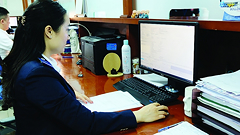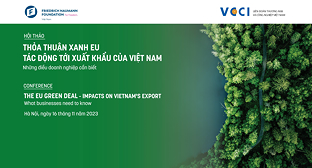Specialised inspection improved
08/04/2021 12:00

The reformed contents in the draft decree on quality inspection and food safety inspection for imported goods play an important role of by information connection, sharing and automated feedback. These contents have been highly appreciated by experts and firmsif technical issues are operated stably.
Method of automated inspection improved
According to the drafting board, the key content of the draft decree that is the principle of quality inspection and food safety inspection for imported goods is performed on the basis of applying risk management and applied for items subject to inspection announced by ministries on the National Single-Window portal.
Methods of quality inspection and food safety inspection include tighten inspection, normal inspection and reduced inspection. Regarding goods with a registration code for conformity announcement or have not yet registered for conformity announcement, if they pass three consecutive tightened inspections, they will be shifted to the normal inspection; if they pass three consecutive tightened inspections, they will be shifted to the reduced inspection.
The inspection method is automatically implemented via the National Single Window. Organisations and individuals search the National Single-Window Portal to determine appropriate inspection methods and submit registration dossiers for quality and food safety inspection.
Pham Thanh Binh, an expert of the USAID-funded Trade Facilitation project, highly appreciated the new approach applying commodity management mechanism instead of the shipment mechanism. At the same time, the inspection is conducted based on a comprehensive risk assessment, including synthesis, risk assessment from many information sources, targeting inspection, with the participation of specialised inspection and management agencies; applyingthe regime of post clearance audit under risk management method to the registration for standard conformity announcement and regulation conformity announcement.
In addition, Binh also highly appreciated provisions in the draft decree on inspection exemption for imported goods that are single goods for warranty or replacement; goods part of a complete equipment chain. All results of procedures that are processed via the National Single Window will be automatically responded to, contributing to publicity, transparency and efficiency in implementing procedures. At the same time, the construction of an interdisciplinary data centre for risk management for import goods with the participation in building, providing and sharing information of all parties involved in the chain of specialised inspection and management procedures is also an important point in the draft decree.
Binh said the draft decree should meet requirements on harmonious handling of three principles: complying with the law and Decision 38/QD-TTg and inheriting goods practices, with three goods points: integrating the procedure for regulation conformity announcement and the procedure for quality inspection into one procedure; performing post clearance audit for most goods, and implementing self-declaration for food products.
As well as implementing the registration for regulation conformity announcement and product announcement at the National Single Window, whether the enterprise has to simultaneously register at agencies as per current provisions or not? At the same time, how to deal with goods registered for regulation conformity announcement and standard conformity announcement before the decree takes effect?
The decree also must stipulate how the importer that registered the standard conformity announcement and regulation conformity announcement and their shipments have been passed three consecutive tighten inspection or normal inspection eligible for import, will use results for being applied simple inspection method. The decree provides many procedures automatically processed by the system, so many technical and technological problems should be handled. If the problems are not processed at the same time, the decree will be inefficient.
Publicised on the National Single Window
Nguyen Van Hung, Yusen Logistics (Vietnam) Company Limited said delegates provided many comments and proposed amendments at a conference in February between the General Department of Customs and Customs Departments of Hanoi, Hai Phong, HCM City and representatives of businesses and associations. These proposals have been noted in this draft. That shows the inquiry and respect for the comments of the drafting board.
The draft has provided some new points, showing the reforms in specialised inspection procedures compared to the past. The draft unified the methods of registration for inspection, handling and announcement of inspection results on the National Single Window. The importer must go through procedures in different methods, including manual method and electronic methods. Thereby, the inspection agencies are decentralised under many levels and sectors. This reform is a great step. The daft regulates the customs authority, quality control agencies, conformity assessment organisations and goods owners must connect with each other to exchange data to create a centralised, unified database which is easy to apply risk management in carrying out procedures and reducingcompliance costs for businesses.
“The application of tightened inspection, normal inspection and reduced inspection is specified, implemented sequentially in a open direction for the business to comply and facilitate the goods import,” Hung said. In addition, the list of goods subject to quality inspection and food safety inspection and standards and technical regulations is publicised on the National Single Window, helping importers easily search and apply instead of regulating in decisions or circulars of each State management agency as before.
Arepresentative of Yusen Logistics (Vietnam) Co., Ltd. said that the putting goods into storage will cutcosts of storage and quick clear goods at the entry border gate. The draft should provide that the putting goods into storage shall be conducted after the firmmeets regulations in point a, point b of clause 1. The sampling at the border gate or at the inland storage of goods will be chosen by the business.
To ensure customs supervision, consignments subject to storage and sampling will be classified into the Red channel and implemented customs seal during being transported from the entry border gate to the registered storage. The Customs where the declaration is registered willcoordinate with the sampling unit and the business to open the seal, conduct a physical inspection and take samples. If the goods can’tbe sealed, the current regulations on customs inspection and supervision for handling will apply.
Method of automated inspection improved
According to the drafting board, the key content of the draft decree that is the principle of quality inspection and food safety inspection for imported goods is performed on the basis of applying risk management and applied for items subject to inspection announced by ministries on the National Single-Window portal.
Methods of quality inspection and food safety inspection include tighten inspection, normal inspection and reduced inspection. Regarding goods with a registration code for conformity announcement or have not yet registered for conformity announcement, if they pass three consecutive tightened inspections, they will be shifted to the normal inspection; if they pass three consecutive tightened inspections, they will be shifted to the reduced inspection.
The inspection method is automatically implemented via the National Single Window. Organisations and individuals search the National Single-Window Portal to determine appropriate inspection methods and submit registration dossiers for quality and food safety inspection.
Pham Thanh Binh, an expert of the USAID-funded Trade Facilitation project, highly appreciated the new approach applying commodity management mechanism instead of the shipment mechanism. At the same time, the inspection is conducted based on a comprehensive risk assessment, including synthesis, risk assessment from many information sources, targeting inspection, with the participation of specialised inspection and management agencies; applyingthe regime of post clearance audit under risk management method to the registration for standard conformity announcement and regulation conformity announcement.
In addition, Binh also highly appreciated provisions in the draft decree on inspection exemption for imported goods that are single goods for warranty or replacement; goods part of a complete equipment chain. All results of procedures that are processed via the National Single Window will be automatically responded to, contributing to publicity, transparency and efficiency in implementing procedures. At the same time, the construction of an interdisciplinary data centre for risk management for import goods with the participation in building, providing and sharing information of all parties involved in the chain of specialised inspection and management procedures is also an important point in the draft decree.
Binh said the draft decree should meet requirements on harmonious handling of three principles: complying with the law and Decision 38/QD-TTg and inheriting goods practices, with three goods points: integrating the procedure for regulation conformity announcement and the procedure for quality inspection into one procedure; performing post clearance audit for most goods, and implementing self-declaration for food products.
As well as implementing the registration for regulation conformity announcement and product announcement at the National Single Window, whether the enterprise has to simultaneously register at agencies as per current provisions or not? At the same time, how to deal with goods registered for regulation conformity announcement and standard conformity announcement before the decree takes effect?
The decree also must stipulate how the importer that registered the standard conformity announcement and regulation conformity announcement and their shipments have been passed three consecutive tighten inspection or normal inspection eligible for import, will use results for being applied simple inspection method. The decree provides many procedures automatically processed by the system, so many technical and technological problems should be handled. If the problems are not processed at the same time, the decree will be inefficient.
Publicised on the National Single Window
Nguyen Van Hung, Yusen Logistics (Vietnam) Company Limited said delegates provided many comments and proposed amendments at a conference in February between the General Department of Customs and Customs Departments of Hanoi, Hai Phong, HCM City and representatives of businesses and associations. These proposals have been noted in this draft. That shows the inquiry and respect for the comments of the drafting board.
The draft has provided some new points, showing the reforms in specialised inspection procedures compared to the past. The draft unified the methods of registration for inspection, handling and announcement of inspection results on the National Single Window. The importer must go through procedures in different methods, including manual method and electronic methods. Thereby, the inspection agencies are decentralised under many levels and sectors. This reform is a great step. The daft regulates the customs authority, quality control agencies, conformity assessment organisations and goods owners must connect with each other to exchange data to create a centralised, unified database which is easy to apply risk management in carrying out procedures and reducingcompliance costs for businesses.
“The application of tightened inspection, normal inspection and reduced inspection is specified, implemented sequentially in a open direction for the business to comply and facilitate the goods import,” Hung said. In addition, the list of goods subject to quality inspection and food safety inspection and standards and technical regulations is publicised on the National Single Window, helping importers easily search and apply instead of regulating in decisions or circulars of each State management agency as before.
Arepresentative of Yusen Logistics (Vietnam) Co., Ltd. said that the putting goods into storage will cutcosts of storage and quick clear goods at the entry border gate. The draft should provide that the putting goods into storage shall be conducted after the firmmeets regulations in point a, point b of clause 1. The sampling at the border gate or at the inland storage of goods will be chosen by the business.
To ensure customs supervision, consignments subject to storage and sampling will be classified into the Red channel and implemented customs seal during being transported from the entry border gate to the registered storage. The Customs where the declaration is registered willcoordinate with the sampling unit and the business to open the seal, conduct a physical inspection and take samples. If the goods can’tbe sealed, the current regulations on customs inspection and supervision for handling will apply.
Source: Customs News
Các tin khác
- Businesses capitalize on recovery momentum to explore market expansion (17/04/2024)
- Canada is second largest consumer of Vietnamese pangasius in CPTPP bloc (17/04/2024)
- India’s tariff removal on several US products benefiting farmers: Katherine Tai (17/04/2024)
- Thailand Contemplates Protective Tariffs on Chinese Imports Amidst Surging Trade Deficit (17/04/2024)
- Vietnam becomes largest banana exporter to Chinese market (17/04/2024)
 Home
Home
 About Us
About Us




















